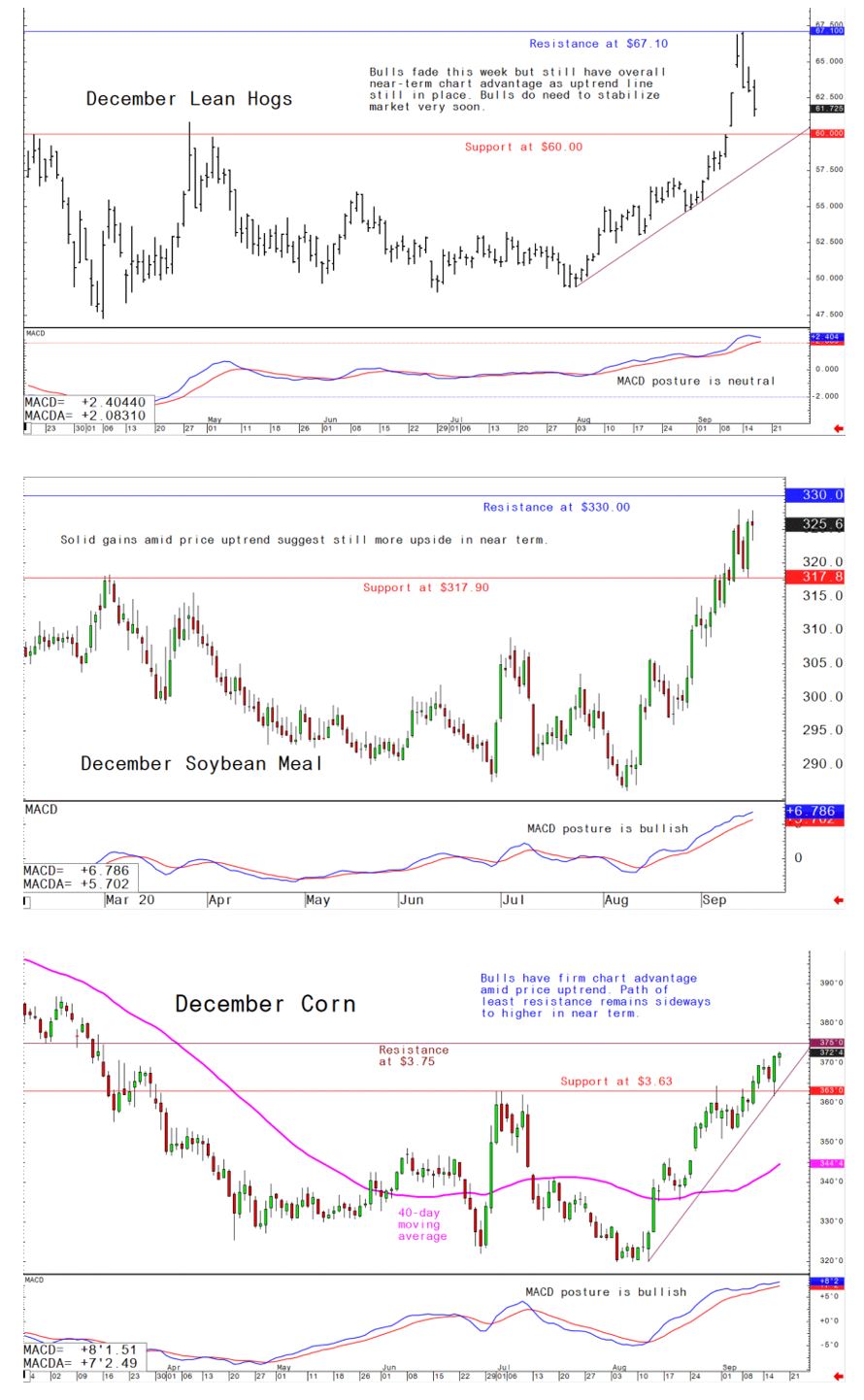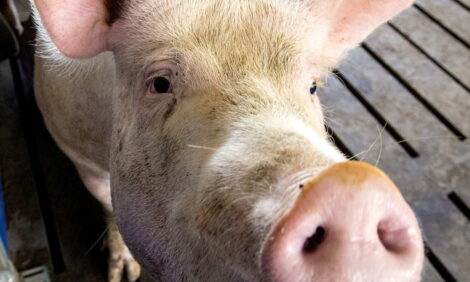



Pig outlook: Lean hog futures bulls need to stop the bleeding
Jim Wyckoff shares cash and technical trading outlook for the swine marketThe pig traders’ perspective: Lean hog futures prices earlier this week saw the lead December contract score a 7.5-month high, only to see prices quickly drop sharply, to put in jeopardy a near-term uptrend on the daily bar chart. Hog market bulls now need to step up and show power very soon to stabilize prices. No serious chart damage has been inflicted, but if futures prices on Friday close out the week at or near their weekly lows, then technical odds would significantly increase that the hog futures market has put in a near-term top and then could only trade sideways-at-best in the coming weeks. Fundamentally, the US pork cutout value has risen recently with all cuts posting gains, and hams and loins leading the charge. Strong pork demand is featured ahead October, the US national pork month. Hog futures traders still expect China’s ban on German pork to lift its already historic US pork imports even higher. Average US hog weights in the central US market jumped 3 pounds the week ending Sept. 12, to 279.7 pounds, but that’s still 1.6 pounds below year-ago levels.
The next week’s likely high-low price trading ranges:
December lean hog futures--$60.00 to $67.10, and with a sideways bias
December soybean meal futures--$317.90 to $330.00, and with a sideways-higher bias
December corn futures--$3.63 to $3.80, and a sideways-higher bias
Latest US Department of Agriculture (USDA) reports, and other news
US pork exports continue at solid pace
USDA on Thursday morning reported US pork net sales of 50,600 metric tons (MT) for 2020 were up 68 percent from the previous week and 41 percent from the prior 4-week average. Increases primarily for China (35,900 MT, including decreases of 200 MT), Mexico (5,900 MT, including decreases of 400 MT), Japan (3,200 MT, including decreases of 400 MT), Canada (1,500 MT, including decreases of 400 MT), and Australia (1,300MT, including decreases of 100 MT), were offset by reductions primarily for Nicaragua (100 MT). For 2021, total net sales of 100 MT were for Australia. Exports of 28,600 MT were down 15 percent from the previous week and 12 percent from the prior 4-week average. The destinations were primarily to Mexico (9,200 MT), China (8,300 MT), Japan (3,700 MT), Canada (1,900 MT), and South Korea (1,400 MT).
US beef net sales of 14,300 MT reported for 2020 were down 8 percent from the previous week and 2 percent from the prior 4-week average. Increases were primarily for South Korea (4,400 MT, including decreases of 300 MT), Japan (4,000 MT, including decreases of 200 MT), China (1,800 MT), Mexico (1,400 MT), and Canada (900 MT, including decreases of 100 MT). For 2021, net sales of 500 MT were primarily for Japan. Exports of 14,100 MT were down 12 percent from the previous week and 19 percent from the prior 4-week average. The destinations were primarily to Japan (4,000 MT), South Korea (3,900 MT), Hong Kong (1,400 MT), Taiwan (1,200 MT), and Mexico (1,000 MT).
USDA: Covid-related shifts could limit South Korea’s pork imports
A US attaché in South Korea recently said Covid-19 pandemic has had a major impact on meat consumption patterns in that country. The post notes, “Domestic pork, mostly eaten at home, benefited while imports are down as restaurants, primary users of imported pork, are seeing reduced traffic,” adding that a similar pattern is playing out for the beef complex. Cattle producers are expanding production in response, which should moderate prices into 2021, “reducing the scope for imports.” The report expects South Korea to import 530,000 MT of beef in 2020 and 520,000 MT of the meat in 2021, which compares to imports of 550,000 MT in 2019. Swine meat imports are expected to slide from 694,000 MT in 2019 to 580,000 MT in 2020 and 600,000 MT in 2021.
Chinese government expects inflation to stabilize amid rising pork supplies
China’s state planner this week said it expects consumer inflation to stabilize within a reasonable range as the country’s pork supply rebounds. Pork makes up a large component of China’s food supply and inflation index, and prices have soared since African swine fever wiped out nearly half of its herd. In August, the country’s food consumer prices index was up 11.2% from year-ago, with pork prices up 52.6% versus August 2019. But that was actually an improvement from 80%-plus gains for pork prices the previous three months. And data out yesterday showed a 31.3% year-over-year jump in the country’s hog herd.
USDA comments on African swine fever in Germany
On September 10, Germany’s Federal Minister of Food and Agriculture confirmed an African swine fever (ASF) case in a wild boar found in Eastern Germany near the German-Polish border. The first ASF case in Germany jeopardizes $867 million in exports to China, which will likely result in increased pork exports from other major suppliers, including the United States, according to a report from USDA. ASF was not entirely unexpected, given the recent rise of cases in Western Poland. However, the confirmed ASF case will be devastating for the German pork sector which is still reeling from the Covid-19 crisis, including slaughter facility disruptions stemming from outbreaks among its workers, excess supply, declining consumption, trade disruptions, and depressed prices.
This is the first ASF case in Germany and it was only a matter of time especially given the recent rise of cases in Western Poland. The risk of introducing the pathogen into Germany was rated as high according to the FLI due to the proximity to the border of the latest Polish cases. However, an introduction by humans via contaminated food cannot be excluded. On-site ASF control measures are being conducted by the general veterinary authorities and the Provincial Crisis Management Center. A fence is now being erected around a 4 km radius of the site where the infected wild boar was found.
Samples taken from bones of the decomposing carcass of the wild boar suggest that ASF entered Germany several weeks ago, indicating that additional ASF detections are likely. Search parties are looking for more dead boar carcasses in the area. ASF is a highly contagious and deadly viral disease affecting both domestic and feral (wild) pigs in all age groups. ASF is not a threat to human health and cannot be transmitted from pigs to humans.
Germany became one of the top pork exporters to China in 2019, with sales reaching $867 million. As a result of the confirmation of ASF in Germany, China and others are expected to ban German pork imports, as was the case when ASF was detected in Poland and other exporting European countries. This will exacerbate the glut of German pork in the EU, which had been fueled by declining domestic consumption. Meanwhile, the German pork sector is still suffering from the impact of Covid19. Outbreaks among workers reduced slaughter capacity. Hog prices are expected to drop even more since the German pork sector is heavily dependent on trade, with exports exceeding $5.9 billion in 2019. While German pork will still be eligible for sale in the EU market, other major global pork producers will need to fill the gap created by Germany’s potential loss of its Chinese pork export market. The United States, Brazil, Spain, Denmark, and the Netherlands may experience a boost in trade.
Large commercial ASF outbreak in northeastern Poland
On September 4, Poland’s Chief Veterinary Officer officially notified an African swine fever (ASF) outbreak on a 6,480-head hog farm in the Warmia and Mazury Province in northeastern Poland. This marks Poland’s third-largest commercial ASF outbreak, to date, in 2020. Veterinary authorities implemented protection and surveillance containment procedures. Since the beginning of 2020, 82 ASF outbreaks have occurred on commercial hog operations in Poland.
USDA’s Canada livestock and products annual report sees herd contraction in 2021
USDA said in its annual report on Canadian livestock that the Canadian cattle herd and swine herds are both expected to contract in 2021. Cattle exports are forecast to grow, beef exports are projected to increase, and Canada will continue to import US feeder cattle. Canadian pork exports are expected to be steady and the United States will remain as the dominant import/export market for Canadian beef and pork products. Both sectors are vulnerable to COVID-19 pandemic impacts.
Overall the Canadian cattle herd is forecast to further decline in 2021. Despite signals for expansion in recent years, poor pasture conditions in some regions have led to increased cow culling and a lack of heifer retention. However, some growth in the 2021 beef cow herd and calf crop is expected due to reduced cow slaughter, increased heifer retention, and improved pasture conditions. Additionally, improved pasture conditions, combined with lower fed cattle prices in early 2020, should support heifer retention.
Canada will continue to import U.S. feeder cattle to supplement the Canadian supply. Increased beef exports are expected assuming market conditions continue to improve as COVID-19 related disruptions, especially in food service globally, are assuaged. Beef imports are forecast down as consumption drops slightly and assuming domestic processing disruptions experienced in 2020 are not repeated.
The Canadian swine herd is expected to decline once again in 2021, however there is discussion of some finishing space expansion which should slow the decline. If space materializes, the 2021 pig crop will grow slightly, following growth in 2020 led by fertility improvements. Canadian exports of feeder swine to the United States will grow following reductions in 2020 but will remain below recent years as more finishing space is available in Canada.
Pork exports will remain steady on 2020 gains as African swine fever (ASF) continues to impact pork availability in certain regions. Imports will also remain steady in 2020 as Canada supplements the domestic supply of highly valued cuts with imported products.
However, Canadian pork consumption is expected to continue to decline as other animal proteins and plant proteins compete for limited space on consumer plates.
Latest analytical daily charts lean hog, soybean meal and corn futures.








